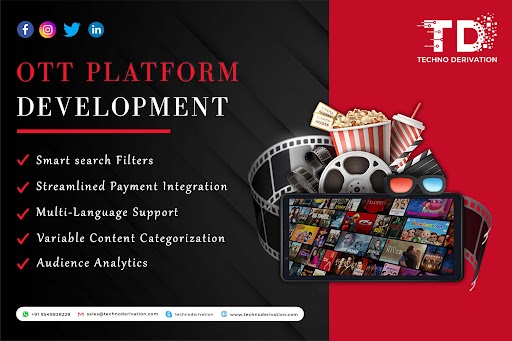
OTT Platform Development: The Ultimate Guide On Cost, Features, Tech
In today’s digital age, Over-The-Top (OTT) platforms have revolutionized the way we consume media. From Netflix and Amazon Prime to Disney+ and Hulu, OTT services have become integral to our entertainment needs. If you’re considering developing your own OTT platform, understanding the cost, essential features, and technology involved is crucial. This guide will provide you with comprehensive insights into OTT platform development.
Understanding OTT Platform Development
OTT platforms deliver video content directly to viewers via the internet, bypassing traditional cable or satellite television services. They offer on-demand content, live streaming, and a vast library of movies, series, and shows. Developing an OTT platform involves multiple stages, from conceptualization and design to development and deployment.
Key Features of OTT Platforms
1. **User Registration and Profiles**:
Users should be able to create accounts and set up personalized profiles. This allows for customized recommendations and a tailored viewing experience.
2. **Content Management System (CMS)**:
A robust CMS is essential for managing and organizing the content library. It should support various content formats and allow easy uploading, editing, and categorization.
3. **Video Streaming and Playback**:
High-quality video streaming with minimal buffering is a must. Adaptive bitrate streaming ensures optimal viewing experiences based on the user’s internet speed.
4. **Search and Discovery**:
Advanced search functionality helps users find content quickly. Recommendations based on viewing history and preferences enhance content discovery.
5. **Multi-Platform Support**:
The platform should be accessible across various devices, including smartphones, tablets, smart TVs, and desktops, ensuring a seamless experience.
6. **Payment Gateway Integration**:
Secure and reliable payment gateways are vital for subscription-based models. Multiple payment options and currency support improve user convenience.
7. **Analytics and Reporting**:
Detailed analytics provide insights into user behavior, content performance, and platform engagement, helping you make informed decisions.
8. **Security Features**:
Implementing DRM (Digital Rights Management), encryption, and secure login mechanisms protects content and user data.
9. **Customer Support**:
Efficient customer support through chat, email, or phone ensures user satisfaction and addresses any issues promptly.
Technology Stack for OTT Platform Development
Developing an OTT platform requires a robust technology stack. Here are some key components:
1. **Frontend Technologies**:
HTML5, CSS3, and JavaScript frameworks like React or Angular are commonly used for developing responsive and interactive user interfaces.
2. **Backend Technologies**:
Node.js, Python, Ruby on Rails, or Java can be used for server-side development, handling business logic, user authentication, and database interactions.
3. **Database Management**:
SQL databases (MySQL, PostgreSQL) or NoSQL databases (MongoDB, Cassandra) store user data, content metadata, and subscription information.
4. **Cloud Services**:
AWS, Google Cloud, or Azure offer scalable infrastructure for hosting, storage, and content delivery. These services also provide CDN (Content Delivery Network) for efficient content distribution.
5. **Streaming Protocols**:
HLS (HTTP Live Streaming) and DASH (Dynamic Adaptive Streaming over HTTP) are widely used for adaptive bitrate streaming, ensuring smooth playback across devices.
6. **Security Measures**:
SSL/TLS for secure data transmission, OAuth for authentication, and DRM solutions like Widevine or PlayReady for content protection.
Cost of OTT Platform Development
The cost of developing an OTT platform varies based on several factors:
1. **Platform Complexity**:
Basic platforms with essential features cost less than advanced platforms with additional functionalities like live streaming, multi-language support, and AI-driven recommendations.
2. **Development Team**:
Hiring an experienced development team, including frontend and backend developers, UI/UX designers, and QA testers, impacts the cost. Outsourcing to regions with lower development costs can be a budget-friendly option.
3. **Technology Stack**:
The choice of technology stack and third-party integrations, such as payment gateways and cloud services, influence the overall cost.
4. **Content Licensing**:
If you’re acquiring content from third-party providers, licensing fees will add to the expenses.
5. **Maintenance and Updates**:
Ongoing maintenance, updates, and feature enhancements are recurring costs that should be factored into the budget.
On average, developing a basic OTT platform can cost between $50,000 to $100,000, while more complex platforms can exceed $200,000.
Conclusion
Developing an OTT platform involves careful planning, choosing the right features, and leveraging a robust technology stack. Understanding the costs and investing in essential functionalities ensures a seamless and engaging user experience. Whether you’re targeting a niche audience or aiming for a broader market, a well-developed OTT platform can position you as a key player in the rapidly evolving digital entertainment landscape. Partnering with an experienced OTT app development company like Techno Derivation can help you navigate this complex process and achieve your business goals.